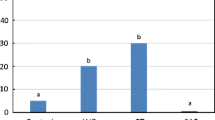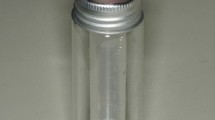The aim of this finite element stress analysis (FEA) study was to assess the effect of separated files (SF) that were broken at two levels (at apical 4 and 9 mm) on the biomechanics of premolars and to determine if removal techniques affect stresses. Six lower premolar teeth were screened on computerized microtomography (micro-CT), standard access cavities were prepared, working lengths were determined, and root canals were prepared (Protaper files, Protaper Universal, Dentsply, Switzerland). Notches were created on the final shaping-file F3 at points 4 and 9 mm from the file tips, inserted in the canals, and squeezed at the apical to break. The roots were rescreened, and SFs were removed by using a Masseran kit (MK; Micro Mega, France), ultrasonic tips (UT; Satelec, Acteon group, France), and the bypass (BP) technique. Final scans were obtained and converted into three-dimensional FEA models. The following conditions were then simulated: a) root-filled tooth with SF; b) root-filled tooth after removal of the SF by using MK, UT, or BP techniques. The models were loaded axially (from two directions) and vertically (300 N), and von Mises stresses were then analyzed. SFs increased the stresses within the root. Longer SFs cause higher stresses within the root and thus should be removed, while short SFs could be kept considering the other clinical factors. Removal via MK caused the highest stresses within the roots among the techniques used. Axial loading caused higher stresses at the cervical side, while the stresses moved toward the apical side under vertical loading. SFs increase the stresses within the root. Long SFs should be removed while short SFs can be left (considering other clinical factors that may affect the success of the treatment). Removing short SFs located at the apical side negatively affects the biomechanics of the teeth, and this effect is more dramatic with the MK technique.







Similar content being viewed by others
References
D. Celik, T. Taşdemir, and K. Er, “Comparison of influence of different manufacturing methods on the cleaning efficiency of rotary nickel-titanium files,” Microsc Res Tech, 76, No. 3, 231–236 (2013).
A. Guelzow, O. Stamm, P. Martus, and A. M. Kielbassa, “Comparative study of six rotary nickel-titanium systems and hand instrumentation for root canal preparation,” Int Endod J, 38, No. 10, 74–752 (2005).
N. Gencoglu and D. Helvacioglu, “Comparison of the different techniques to remove fractured endodontic instruments from root canal systems,” Eur J Dent, 3, No. 2, 90–95 (2009).
P. Parashos and H. H. Messer, “Rotary NiTi instrument fracture and its consequences,” J Endod, 32, No. 11, 1031–1043 (2006).
A. A. Madarati, M. J. Hunter, and P. M. Dummer, “Management of intracanal separated instruments,” J Endod, 39, No. 5, 569–581 (2013).
O. Yoldas, H. Oztunc, C. Tinaz, and N. Alparslan, “Perforation risks associated with the use of Masserann endodontic kit drills in mandibular molars,” Oral Surg Oral Med Oral Pathol Oral Radiol Endod, 97, No. 4, 513–517 (2004).
A. K. Thirumalai, M. Sekar, and S. Mylswamy, “Retrieval of a separated instrument using Masserann technique,” J Conserv Dent, 11, No. 1, 42–45 (2008).
M. Hülsmann, “Methods for removing metal obstructions from the root canal,” Endod Dent Traumatol, 9, No. 6, 223–237 (1993).
A. Adl, A. Shahravan, M. Farshad, and S. Honar, “Success rate and time for bypassing the fractured segments of four NiTi rotary instruments,” Iran Endod J, 12, No. 3, 349–353 (2017).
G. Nevares, R. S. Cunha, M. L. Zuolo, and C. E. Bueno, “Success rates for removing or bypassing fractured instruments: a prospective clinical study,” J Endod, 38, No. 4, 442–444 (2012).
H. Shahabinejad, A. Ghassemi, L. Pishbin, and A. Shahravan, “Success of ultrasonic technique in removing fractured rotary nickel-titanium endodontic instruments from root canals and its effect on the required force for root fracture,” J Endod, 39, No. 6, 824–828 (2013).
M. Hülsmann and I. Schinkel, “Influence of several factors on the success or failure of removal of fractured instruments from the root canal,” Endod Dent Traumatol, 15, No. 6, 252–258 (1999).
J. Cujé, C. Bargholz, and M. Hülsmann, “The outcome of retained instrument removal in a specialist practice,” Int Endod J, 43, No. 7, 545–554 (2010).
Y. Shen, B. Peng, and G. S. Cheung, “Factors associated with the removal of fractured NiTi instruments from root canal systems,” Oral Surg Oral Med Oral Pathol Oral Radiol Endod. 98, No. 5, 60–610 (2004).
J. R. Ward, P. Parashos, and H. H. Messer, “Evaluation of an ultrasonic technique to remove fractured rotary nickel-titanium endodontic instruments from root canals: an experimental study,” J Endod, 29, No. 11, 756– 763 (2003).
J. Chen, L. Yue, J. D. Wang, and X. J. Gao, “The correlation between the enlargement of root canal diameter and the fracture strength and the stress distribution of root,” [in Chinese],Chinese Journal of Stomatology, 41, No. 11, 661–663 (2006).
V. Lertchirakarn, J. E. Palamara, and H. H. Messer, “Patterns of vertical root fracture: factors affecting stress distribution in the root canal,” J Endod, 29, No. 8, 523–528 (2003).
C. Sathorn, J. E. Palamara, and H. H. Messer, “A comparison of the effects of two canal preparation techniques on root fracture susceptibility and fracture pattern,” J Endod, 31, No. 4, 283–287 (2005).
S. Belli, O. Eraslan, G. Eskitascioglu, V. Karbhari, “Monoblocks in root canals: a finite elemental stress analysis study,” Int Endod J, 44, No. 9, 817–826 (2011).
R. Eken, O. G. Sen, G. Eskitascioglu, and S. Belli, “Evaluation of the effect of rotary systems on stresses in a new testing model using a 3-dimensional printed simulated resin root with an oval-shaped canal: a finite element analysis study,” J Endod, 42, No. 8, 1273–1278 (2016).
C. C. Ko, C. S. Chu, K. H. Chung, M. C. Lee, “Effects of posts on dentin stress distribution in pulpless teeth,” J Prosth Dent, 68, No. 3, 421–427 (1992).
A. Pegoretti, L. Fambri, G. Zappini, and M. Bianchetti, “Finite element analysis of a glass fiber reinforced composite endodontic post,” Biomaterials, 23, No. 13, 2667–2682 (2002).
S. P. Ho, H. Goodis, M. Balooch, et al., “The effect of sample preparation technique on determination of structure and nanomechanical properties of human cementum hard tissue,” Biomaterials, 25, No. 19, 4847– 4857 (2004).
S. V. Singh, S. Gupta, and D. Sharma, “Stress distribution of posts on the endodontically treated teeth with and without bone height augmentation: A three-dimensional finite element analysis,” J Conserv Dent, 18, No. 3, 196 (2015).
S. Belli, G.Eskitaşcioǧlu, O. Eraslan, et al., “Effect of hybrid layer on stress distribution in a premolar tooth restored with composite or ceramic inlay: an FEM study,” J Biomed Mater Res, Part B: Applied Biomaterials, 74, No. 2, 665–668 (2005).
C. Rubin, N. Krishnamurthy, E. Capilouto, and H. Yi, “Stress analysis of the human tooth using a three-dimensional finite element model,” J Dent Res, 62, No. 2, 82–86 (1983).
D. C. Holmes, A. M. Diaz-Arnold, and J. M. Leary, “Influence of post dimension on stress distribution in dentin,” J Prosth Dent, 75, No. 2, 140–147 (1996).
M. Galal, A. G. Ismail, N. Omar, M. Zaazou, M. A. Nassar, “Influence of thermomechanical treatment on the mechanical behavior of protaper gold versus protaper universal (a finite element study),” Open Access Maced J Med Sci, 7, No. 13, 2157–2161 (2019).
C. Ungerechts, A. Bårdsen, I. Fristad, “Instrument fracture in root canals – where why, when and what? A study from a student clinic,” Int Endod J, 47, No. 2, 183–190 (2014).
M. K. Iqbal, M. R. Kohli, and J. S. Kim, “A retrospective clinical study of incidence of root canal instrument separation in an endodontics graduate program: a PennEndo database study,” J Endod, 32, No. 11, 1048–1052 (2006).
G. N. Tzanetakis, E. G. Kontakiotis, D. V. Maurikou, and M. P. Marzelou, “Prevalence and management of instrument fracture in the postgraduate endodontic program at the Dental School of Athens: a five-year retrospective clinical study,” J Endod, 34, No. 6, 675–678 (2008).
A. Shenoy, P. Mandava, N. Bolla, and S. Vemuri, “A novel technique for removal of broken instrument from root canal in mandibular second molar,” Indian J Dent Res, 25, No. 1, 107–110 (2014).
A. R. Vivekananda Pai, S. Mir, and R. Jain,”Retrieval of a metallic obstruction from the root canal of a premolar using Masserann technique,” Contemp Clin Dent, 4, No. 4, 543–56 9 (2013).
M. Gerek, E. D. Başer, M. B. Kayahan, et al., “Comparison of the force required to fracture roots vertically after ultrasonic and Masserann removal of broken instruments,” Int Endod J, 45, No. 5, 429–434 (2012).
N. Ni, J. Ye, L. Wang, S. Shen, et al., “Stress distribution in a mandibular premolar after separated nickel-titanium instrument removal and root canal preparation: a three-dimensional finite element analysis,” J Int Med Res, 47, No. 4, 1555–1564 (2019).
A. Ossareh, M. Rosentritt, and A. Kishen, “Biomechanical studies on the effect of iatrogenic dentin removal on vertical root fractures,” J Conserv Dent, 21, No. 3, 290–296 (2018).
M. Fu, X. Huang, K. Zhang, and B. Hou, “Effects of ultrasonic removal of fractured files from the middle third of root canals on the resistance to vertical root fracture,” J Endod, 45, No. 11, 1365–1370 (2019).
F. Ebrahimi, “Finite element analysis: new trends and developments,” Intechopen (2012). https://doi.org/10.5772/3352
A. Kishen, “Mechanisms and risk factors for fracture predilection in endodontically treated teeth,” Endod Topics, 13, No. 1, 57–83 (2006).
F. Maceri, M. Martignoni, and G. Vairo, “Mechanical behavior of endodontic restorations with multiple prefabricated posts: a finite-element approach,” J Biomech, 40, No. 11, 2386–2398 (2007).
M. K. Boadu, E. O. Abankwa, and L. A. Anaba, “A concise review on applications and challenges of stress analysis,” Int J Sci Tech Res Eng, 4, No. 6, 1–5 (2019).
E. Asmussen, A. Peutzfeldt, and A. Sahafim, “Finite element analysis of stresses in endodontically treated, dowel-restored teeth,” J Prosth Dent, 94, No. 4, 321–329 (2005).
A Apicella, “Biomimetics and biomechanics: a new methodological approach to improve the reliability of restoration systems,” in: Fiber Posts and Endodontically Treated Teeth: A Compendium of Scientific and Clinical Perspectives, Modern Dentistry Media, Wendywood, South Africa (2008).
S. Belli, O. Eraslan, G. Eskitascioglu, and V. Karbhari, “Monoblocks in root canals: a finite elemental stress analysis study,” Int Endod J, 44, No. 9, 817–826 (2011).
Author information
Authors and Affiliations
Corresponding author
Additional information
Translated from Problemy Mitsnosti, No. 1, p. 146, January – February, 2023.
Rights and permissions
Springer Nature or its licensor (e.g. a society or other partner) holds exclusive rights to this article under a publishing agreement with the author(s) or other rightsholder(s); author self-archiving of the accepted manuscript version of this article is solely governed by the terms of such publishing agreement and applicable law.
About this article
Cite this article
Ahadov, V., Belli, S. Effect of Separated Files on Biomechanics of Premolars: von Mises Stress Analysis via a FEM Study. Strength Mater 55, 226–237 (2023). https://doi.org/10.1007/s11223-023-00516-5
Received:
Published:
Issue Date:
DOI: https://doi.org/10.1007/s11223-023-00516-5




